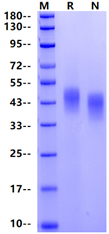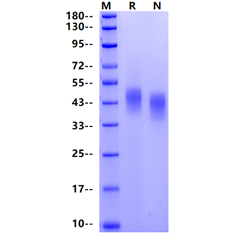Product Details
Product Details
Product Specification
| Species | Cynomolgus |
| Synonyms | Siglec-3, CD33, gp67 |
| Accession | XP_045235686.1 |
| Amino Acid Sequence | Met16-Gly248, with C-terminal 8*His MDPRVRLEVQESVTVQEGLCVLVPCTFFHPVPYHTRNSPVHGYWFREGAIVSLDSPVATNKLDQEVQEETQGRFRLLGDPSRNNCSLSIVDARRRDNGSYFFRMEKGSTKYSYKSTQLSVHVTDLTHRPQILIPGALDPDHSKNLTCSVPWACEQGTPPIFSWMSAAPTSLGLRTTHSSVLIITPRPQDHGTNLTCQVKFPGAGVTTERTIQLNVSYASQNPRTDIFLGDGSGGGGSHHHHHHHH |
| Expression System | HEK293 |
| Molecular Weight | 40-50kDa |
| Purity | >95% by SDS-PAGE |
| Endotoxin | <0.1EU/μg |
| Conjugation | Unconjugated |
| Tag | His Tag |
| Physical Appearance | Lyophilized Powder |
| Storage Buffer | PBS, pH7.4 |
| Reconstitution | Reconstitute at 0.1-1 mg/ml according to the size in ultrapure water after rapid centrifugation. |
| Stability & Storage | · 12 months from date of receipt, lyophilized powder stored at -20 to -80℃. · 3 months, -20 to -80℃ under sterile conditions after reconstitution. · 1 week, 2 to 8℃ under sterile conditions after reconstitution. · Please avoid repeated freeze-thaw cycles. |
| Reference |
1、Ulyanova T. et al. (1999) The sialoadhesin CD33 is a myeloid-specific inhibitory receptor. Eur J Immunol. 29(11): 3440-9. 2、Freeman S D. et al. (1995) Characterization of CD33 as a new member of the sialoadhesin family of cellular interaction molecules. Blood. 85(8): 2005-12. |
Background
Sialic acid-binding immunoglobulin-like lectins (Siglecs)1 are transmembrane sialic acid-binding proteins of the immunoglobulin (Ig) superfamily characterized by the presence of an N-terminal V-set Ig-like domain and variable numbers of C2 set domains (1). The first Siglecs to be characterized were Siglec-1, Siglec-2, Siglec-3 and myelin-associated Siglec-4 which share ∼25–30% sequence identity within the extracellular regions. Recent studies have uncovered the existence of a cluster of genes on human chromosome 19q13.3-4 that encode novel Siglecs highly related to CD33. This CD33-related subgroup includes Siglecs-3, -5, -6, -7, and -8, each of which share ∼50–70% sequence identity. These differences in expression and ligand binding suggest that each Siglec mediates a specific, nonredundant function in hemopoietic cell biology. CD33 (siglec-3) is the smallest siglec member. It preferentially binds to α2-6- and α2-3-sialylated glycans and strongly binds to sialylated ligands on leukemic cell line. Recently, the C1q complement system component has been established as a soluble ligand for CD33. CD33 is mainly expressed in the surface of human leukocytes of the myeloid lineage; however, it is important to note that it can also be expressed on lymphoid cells, including NK cells at several differentiation stages. Human CD33 is expressed on the cell membrane as two isoforms, CD33M, the full-length protein, and CD33m, lacking the V extracellular domain. The CD33 expression level has been recently related to Alzheimer’s disease pathology, autoimmune diseases such as systemic lupus erythematosus (SLE), type II diabetes, or infection.
Picture
Picture
SDS-PAGE

1μg (R: reducing condition, N: non-reducing condition).


